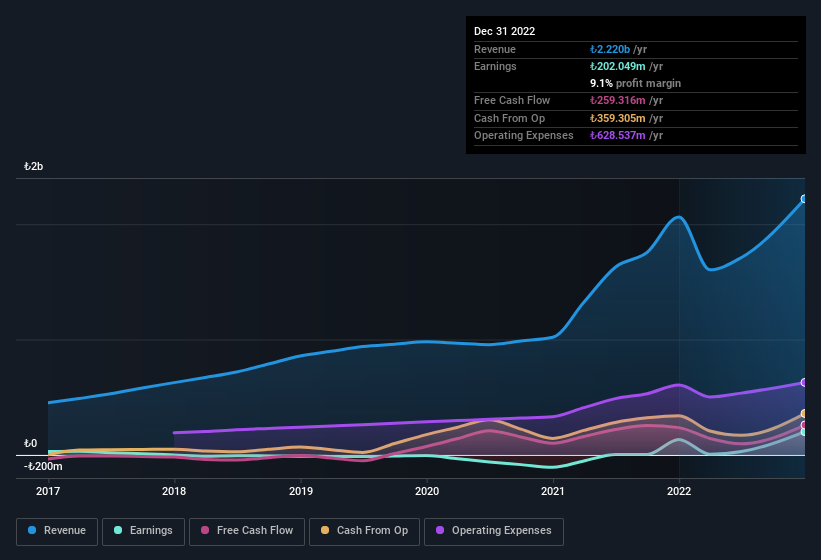Stock Analysis
- United Kingdom
- /
- Hospitality
- /
- LSE:DPEU
Statutory Profit Doesn't Reflect How Good DP Eurasia's (LON:DPEU) Earnings Are

DP Eurasia N.V. (LON:DPEU) just reported healthy earnings but the stock price didn't move much. Our analysis suggests that investors might be missing some promising details.
See our latest analysis for DP Eurasia

Examining Cashflow Against DP Eurasia's Earnings
Many investors haven't heard of the accrual ratio from cashflow, but it is actually a useful measure of how well a company's profit is backed up by free cash flow (FCF) during a given period. To get the accrual ratio we first subtract FCF from profit for a period, and then divide that number by the average operating assets for the period. The ratio shows us how much a company's profit exceeds its FCF.
Therefore, it's actually considered a good thing when a company has a negative accrual ratio, but a bad thing if its accrual ratio is positive. That is not intended to imply we should worry about a positive accrual ratio, but it's worth noting where the accrual ratio is rather high. To quote a 2014 paper by Lewellen and Resutek, "firms with higher accruals tend to be less profitable in the future".
For the year to December 2022, DP Eurasia had an accrual ratio of -0.10. Therefore, its statutory earnings were quite a lot less than its free cashflow. Indeed, in the last twelve months it reported free cash flow of ₺259m, well over the ₺202.0m it reported in profit. DP Eurasia shareholders are no doubt pleased that free cash flow improved over the last twelve months.
That might leave you wondering what analysts are forecasting in terms of future profitability. Luckily, you can click here to see an interactive graph depicting future profitability, based on their estimates.
Our Take On DP Eurasia's Profit Performance
DP Eurasia's accrual ratio is solid, and indicates strong free cash flow, as we discussed, above. Based on this observation, we consider it likely that DP Eurasia's statutory profit actually understates its earnings potential! And on top of that, its earnings per share increased by 51% in the last year. The goal of this article has been to assess how well we can rely on the statutory earnings to reflect the company's potential, but there is plenty more to consider. If you'd like to know more about DP Eurasia as a business, it's important to be aware of any risks it's facing. Be aware that DP Eurasia is showing 3 warning signs in our investment analysis and 1 of those doesn't sit too well with us...
Today we've zoomed in on a single data point to better understand the nature of DP Eurasia's profit. But there is always more to discover if you are capable of focussing your mind on minutiae. For example, many people consider a high return on equity as an indication of favorable business economics, while others like to 'follow the money' and search out stocks that insiders are buying. While it might take a little research on your behalf, you may find this free collection of companies boasting high return on equity, or this list of stocks that insiders are buying to be useful.
Valuation is complex, but we're helping make it simple.
Find out whether DP Eurasia is potentially over or undervalued by checking out our comprehensive analysis, which includes fair value estimates, risks and warnings, dividends, insider transactions and financial health.
View the Free AnalysisHave feedback on this article? Concerned about the content? Get in touch with us directly. Alternatively, email editorial-team (at) simplywallst.com.
This article by Simply Wall St is general in nature. We provide commentary based on historical data and analyst forecasts only using an unbiased methodology and our articles are not intended to be financial advice. It does not constitute a recommendation to buy or sell any stock, and does not take account of your objectives, or your financial situation. We aim to bring you long-term focused analysis driven by fundamental data. Note that our analysis may not factor in the latest price-sensitive company announcements or qualitative material. Simply Wall St has no position in any stocks mentioned.
About LSE:DPEU
DP Eurasia
DP Eurasia N.V., together with its subsidiaries, engages in the operation of corporate-owned and franchised stores under the Domino’s Pizza brand name in Turkey, Russia, Azerbaijan, and Georgia.
Acceptable track record with worrying balance sheet.

